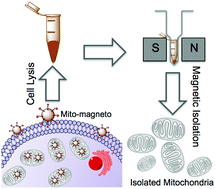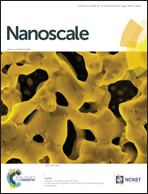Mito-magneto: a tool for nanoparticle mediated mitochondria isolation†
Abstract
The field of intracellular organelle targeting using nanoparticle (NP) is mushrooming rapidly. Thus, the area of nanotechnology-enabled targeting of mitochondrion, the cellular powerhouse, for diseases characterized by mitochondrial dysfunctions such as cancer, diseases of the central nervous system, and cardiovascular diseases is also growing at a rapid pace. Optimization of a NP's ability to target the mitochondria requires quantification of the particles in this subcellular organelle and isolation of mitochondria from the cells. Conventional gradient centrifugation used in currently available methods may not be appropriate for NP containing mitochondria isolation as these particles undergo Brownian motion under centrifugal forces yielding irreproducible results. There is only one method for centrifugation-free mitochondria isolation; however, this method requires immunoprecipitation. Thus, a reliable centrifugation and immunoprecipitation free method is urgently needed to support this growing field of nanotechnology-based mitochondria targeting. Here, we report a mitochondria-targeted magnetic NP, Mito-magneto, to avoid centrifugation and immunoprecipitation methods for isolation of functional, respiration active pure mitochondria, which can be used to analyze and quantify mitochondria targeting properties of various NPs as an important tool for the growing field of “mitochondrial nanomedicine”.


 Please wait while we load your content...
Please wait while we load your content...